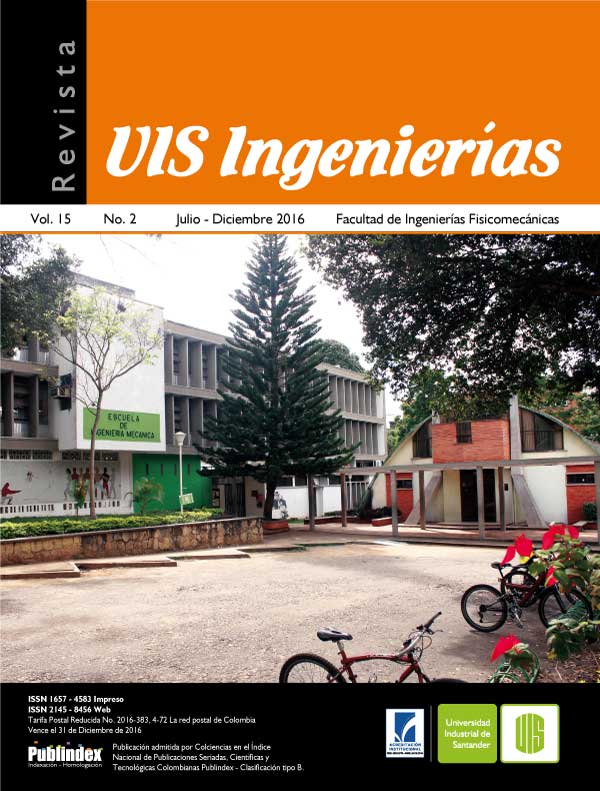Application of the least squares inversion method for vertical electrical sounding processing in the Colorado field (Santander) –a case study
Published 2016-06-01
Keywords
- Electrical method,
- Colorado Field,
- vertical electrical sounding,
- water table,
- aquifer
- inversion ...More
How to Cite
Abstract
In the resistivity method, artificially generated electric currents are introduced into the ground and the resulting potential differences are measured at the surface, in subsurface layers of different physical characteristics, resistivity measurements and their respective anomalies provide information on the form and electrical properties of subsurface inhomogeneities. Resistivity is one of the most variable physical properties because it can be affected by small changes in climate or subfloor, for certain types of materials, water can modify their electrical properties; in saturated soil or water tables, the resistivity of a material tends to decrease. The distribution of lower resistivity ranges for different points are analyzed in order to estimate a surface distribution of these saturated levels. At Colorado Field was survey eight vertical electrical sounding; processing and interpretation of acquired data is done through the development of an investment using least squares to estimate the actual resistivity and depths that are best suited to modeling the theoretical curve
Downloads
References
- Advanced Geosciences Incorporated. 2009. Advanced Resistivity Imaging Seminar. Austin (Texas), April 16. 25p.
- Butler D. K. 2008. "What Is Near-Surface Geophysics." In Near-Surface Geophysics, by Dwain K. Butler, 1-6. Tulsa: Society of Exploration Geophysicist.
- Caballero V., Parra M., Mora Bohorquez R. 2010. Levantamiento de la cordillera oriental de Colombia durante el eoceno tardío – oligoceno temprano: proveniencia sedimentaria en el sinclinal de nuevo mundo, cuenca valle medio del magdalena. Boletín de Geología 32 (1): 45-77.
- Ekinci Y. L. & Demirci A. 2009. A Damped least-squares inversion program for the interpretation of schlumberger sounding curves. Journal of Applied Sciences 8 (22): 4070-4078.
- Gómez E., Jordan T., Allmendnger R., Hegarty K., Kelley S. Syntectonic Cenozoic Sedimentation in the Northern Middle Magdalena Valley Basin of Colombia and Implications for Exhumation of the Northern Andes. Geological Society of America Bulletin, 547-569, 2008.
- Gibson P. J., & George D. M., 2003. Environmental Applications of Geophysical Surveying Techniques. Hauppauge: Nova Science Publishers.
- Greenhouse J. P. & Gudjurgis D. S. 1998. Introduction to Environmental and Engineering Geophysics." SAGEEP (98). Chicago.
- Holzbecher, L. 2007. Environmental modeling using Matlab. Springer-Verlag, Berlin Heidelberg, 393p. LIBRO
- Hubbard J. L. 2009. Use of electrical resistivity and multichannel analysis of surface wave geophysical tomography in geotechnical site characterization of dam. Master of Science thesis. The University of Texas at Arlington.
- Koefoed, O. 1970. A fast method for determining the layer distribution from a raised kernel function in geoelectrical sounding. Geophysics prospect (18): 564-570.
- Loke, M.H. & Lane, J.W., 2004. Inversion of data from electrical resistivity imaging surveys in water-covered areas. Exploration Geophysics. (35) 266-271.
- Steeples D. 2001. Near-surface seismology: a short course. Lawrence: Society of Exploration Geophysics.
- Society of Exploration Geophysicist of Japan. 2004. Application of Geophysical Methods to Engineering and Environmental Problems. Tokyo: Society of Exploration Geophysicist of Japan.
- United States Corps of Engineers. 2001. Geotechnical Investigations. Engineering Manual No. 1110-1-1804, Washington D.C.
- Zafra, M. 2013. Cartografía geológica del campo colorado a escala 1:25.000. Tesis de pregrado – Universidad Industrial de Santander.

